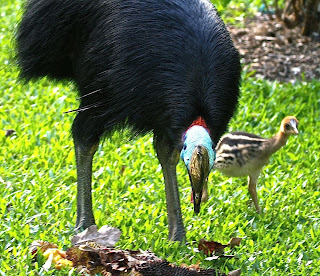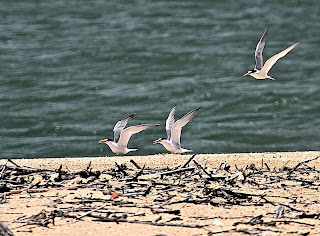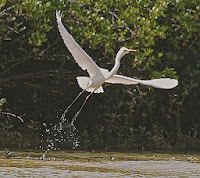Its the end of the year so please forgive me while I ruminate over the last year and a little of what it has meant for the environment of Australia. If 13 is an unlucky number, we could say 2013 has been an unlucky year for the Environment of our planet with the global population topping 7 billion and growing. In Australia the last year has seen environmental legislation wound back, so what will happen in 2014? The number 14 is considered to be the worst number amongst all the unlucky numbers. In Mandarin the number 14 is almost homophonous with the Chinese word 'si' which means death. Can we hope it may become a sign to people around the world that we have pushed the ecological systems of our planet to the point of no-return.
 Almost two years of the Newman Government in Queensland has seen dramatic changes to legislation governing our Environment and Civil Liberties. Environmental Laws governing development applications are now the responsibility of Local Government with no oversight of the State unless the project is deemed to be a significant project and then the development is 'fast-tracked' by the Co-ordinator General's Department and the locals have to live with, and pay for, the shortcuts.
Almost two years of the Newman Government in Queensland has seen dramatic changes to legislation governing our Environment and Civil Liberties. Environmental Laws governing development applications are now the responsibility of Local Government with no oversight of the State unless the project is deemed to be a significant project and then the development is 'fast-tracked' by the Co-ordinator General's Department and the locals have to live with, and pay for, the shortcuts.Changes to the Vegetation Management Act, (VMA), mean that land holders now self access vegetation types on their properties before clearing, thus enabling landholders to clear remnant vegetation. Driving around north Queensland it is easy to see essential riparian vegetation disappearing before your eyes - along watercourses and in wetlands. This is in spite of Mr Powell, the Queensland Minister for the Environment, declaring in Parliament that 50 metres of mapped watercourses in priority catchments will remain regulated under the VMA. The critical words are 'mapped' and 'priority catchments', apparently the Johnston Rivers and their tributes are neither 'mapped' nor 'priority catchments', or perhaps no one is looking.
The Wild Rivers Legislation has been wound back and expressions of interest have been advertised for mining exploration throughout Cape York.
 The Newman Government has a 'hands off' approach to regulation with Mining Companies and believes that Corporates can self regulate in the Nation's interest. No officer from the Queensland Department of the Environment inspected the June 2013 Santos oil spill in southwest Queensland. Before the removal of the legislation the watercourses of this area were protected under the Wild Rivers Legislation as they are part of the Channel Country which flows in to Lake Eyre. When Lake Eyre floods millions of migratory birds are drawn to the area to breed. Pollution of this area would be a disaster for many species.
The Newman Government has a 'hands off' approach to regulation with Mining Companies and believes that Corporates can self regulate in the Nation's interest. No officer from the Queensland Department of the Environment inspected the June 2013 Santos oil spill in southwest Queensland. Before the removal of the legislation the watercourses of this area were protected under the Wild Rivers Legislation as they are part of the Channel Country which flows in to Lake Eyre. When Lake Eyre floods millions of migratory birds are drawn to the area to breed. Pollution of this area would be a disaster for many species.The Newman Government has allowed grazing in National Parks and is inviting expressions of interest from companies wishing to develop tourism operations within National Parks. In addition virtually all crocodiles have been removed from waterways in Queensland including within National Parks.
The Queensland Government has just released the first stage of a draft master plan for National Parks in Queensland and it is open for public consultation. The first three areas are Walkabout Creek Visitor Centre, David Fleay Wildlife Park and Mon Repos Conservation Park. For any enquiries about any of the draft master plans email qpwsmasterplan@nprsr.qld.gov.au What happens with these parks will no doubt set the guide-lines for all National Parks.
Finally, the new Queensland laws, supposedly framed to control criminal elements within Bikie Gangs, are so broad, and do not specify Bikies, they can be applied to any citizen. I believe these laws have been framed to control all Queensland citizens when and if deemed necessary by the Newman Government - very scary.
 The new Abbott Federal Government is 103 days old and in that short time has wound back the environment clock a full decade. Now, more than ever, we need firm legislative protection for endangered and threatened species and their habitat, but what do we see?
The new Abbott Federal Government is 103 days old and in that short time has wound back the environment clock a full decade. Now, more than ever, we need firm legislative protection for endangered and threatened species and their habitat, but what do we see?One of the Prime Minister's first moves on gaining Government was to dismantle the carbon tax and the new Minister for the Environment Greg Hunt sacked 150 people in his Department. Greg Hunt states he has a blueprint to transform the nation's environmental laws.
An amendment to the Environment Protection and Biodiversity Conservation Act 1999 (EPBC Act) and the Great Barrier Reef Marine Park Act 1975 if successfully passed will absolves the Federal Government of liability or responsibility in the event of any Environmental mishap. The Amendment Bill has passed the House of Representatives and is now at the second reading stage in the Senate. Only a public outcry will prevent this legislation from proceeding.
Tony Abbott's one liner, 'one-stop shop for environmental approval' is a superficial cliche which ignores the responsibility of the Federal Government to retain oversight on actions that significantly impact on matters of national environmental significance. State Governments and Territories have signed bilateral agreements creating a single environmental assessment process.
Unless the people of Australia tell their politicians what they want, the politicians will follow the vested interests of the loudest corporate lobby group. One wonders how shrivelled are the hearts and souls of our politicians that they do not care for the creatures on our planet?
But it is not all gloom some bouquets must be given. The Federal Minister for the Environment, Greg Hunt has given $300,000 dollars for turtle rescue and rehabilitation. The Minister also put a stop to sea dumping of dredge spoil at Gladstone Port. Best of all the Mamu people of the Johnstone River were handed back their Native Title by His Honour Justice John Alfred Dowsett AM, Judge of the Federal Court of Australia on the 1st November 2013, in Innisfail.

 Meanwhile, here at Coquette Point the Cassowaries have resolved their territorial disputes. Jessie struts with attitude through the paddock early every morning when she hears the Pied Imperial Pigeons (PIPs) feeding on the now ripe fruit of the Damson plum, Terminalia sericocarpa. She hurries to the trees where a shower of ripe plums rain down around her. The fluttering PIPs knock more fruit off the tree then they eat as they move from branch to branch.
Meanwhile, here at Coquette Point the Cassowaries have resolved their territorial disputes. Jessie struts with attitude through the paddock early every morning when she hears the Pied Imperial Pigeons (PIPs) feeding on the now ripe fruit of the Damson plum, Terminalia sericocarpa. She hurries to the trees where a shower of ripe plums rain down around her. The fluttering PIPs knock more fruit off the tree then they eat as they move from branch to branch.Young cassowary 'Q' is keeping to the mangrove and hibiscus forest along the riverbank and occasionally you may get a glimpses of her as she goes about her food gathering each day.
On Tuesday night we had a good shower of rain and in the morning the sun shone brightly. I found 'Q' at daylight soaking up the first rays of the sun and drying her sodden feathers.

………………………..Can you find 'Q' in this photo?
 Cassowary 'Snout' is visiting the Damson plum regularly with his chick. He walks through the orchard mid to late afternoon and never seems to cross Jessie's path.
Cassowary 'Snout' is visiting the Damson plum regularly with his chick. He walks through the orchard mid to late afternoon and never seems to cross Jessie's path.Snout makes clucking noises and shows the chick what to eat.
The chick is already starting to develop wattles and had just been for a swim in the pond when I took this photo on the left. Unfortunately, I missed the photo of Snout and the chick swimming, no camera, but it was simply wonderful to see.


The chick is full of confidence and I often see it leading Snout as they enter the rainforest.
I have heard some good reports on the birth of new cassowary chicks around the region. At Etty Bay the matriarch has remained with the male and they have three chicks. At El Arish, down Granadilla Road two male cassowaries have three chicks each. and between Bombeeta Road and Warrakin Road at Mena Creek a cassowary dad has been seen, also with three chicks.
Let us hope most of these chick will survive this coming year.

As I said the PIPs are feasting hungrily on the Damson. 20 or more pigeons fly in at sunrise and some pigeons remain in the tree throughout the day. Late in the afternoon the numbers of pigeons again builds and they coo and whiz their wings as the shift around in the canopy feasting and socialising.
The Damson tree is one of the giants of the rainforest, the branches are layered and the wide canopy provides deep, cool shade on the forest floor. The small fruits turn purple as they ripen and the thin flesh can be made into jam or wine. Aboriginal people ate these small plum fruits.
When the pigeons have eaten their fill some birds remain in the tree to socialise.
While others move away to a nearby fig to rest. No doubt they are the visitors and although the six resident birds allow the visitors to share in the abundance of the Damson they draw the territorial line when it come to preening time and you can hear the residents utter loud, sharp clucking sounds as they claim their territory.
Some of the birds have deep yellow colouring on their underside feathers, an indication that these birds are still breeding.


If you look into the canopy of the Damson tree you are sure to see a flash of blue, as this tree is the host plant for the oak-blue butterflies.
 Other birds are sharing the feast of plums, shining starlings, fig birds and varied thrillers are regular visitors.
Other birds are sharing the feast of plums, shining starlings, fig birds and varied thrillers are regular visitors.

Fruiting at the same time as the Damson and nearby in the forest are native olive trees, Chionanthaus ramiflora.
The native olive generally grows to form a small rambling tree and is found in littoral and open forest. The fruits are favoured by cassowaries and pigeons. It is not coincidental that the hatching of cassowary chicks generally coincides with the fruiting of the Damson plum the Native Olive and Pandanus.

The warm summer weather always brings an increase in insect activity. The variety of insects that live in the rainforest continues to surprise anyone that looks.
I found this Leaf Katydid, most unusually in leaf litter, and it reminded me how special these creatures are and of an unusual Katydid Russell Constable, Deb P, and I saw when we were looking for frogs at Ella Bay - very late one night this year. Russell managed to get a photo of the Piggy Back Katydid which turned out to be an undescribed species in the genus Chloracantha. Entomologist David Rentz discovered it and he will be submitting a paper describing this Katydid late next month. It is hard to believe that in 2013 we are still discovering new species in the rain forests right in our own backyards.

 With the increasing summer humidity Jumping Spiders are very active and this week I have seen lots of my old friends hanging about looking for food. Coquette Point, with its melaleuca forests appears to be a hot spot for a diverse range of jumping spiders.
With the increasing summer humidity Jumping Spiders are very active and this week I have seen lots of my old friends hanging about looking for food. Coquette Point, with its melaleuca forests appears to be a hot spot for a diverse range of jumping spiders.
The loud, continuous notes of the male cicadas as they sing together, perhaps announcing the imminent arrival of the monsoon, has been background noise all this week.
The second cyclone of the season has formed off Western Australia and is expected to track south and cross the coast near Karratha on New Year's Eve. The cyclone is not expected to pull the monsoon trough down nor have any effect on FNQ's weather; fine, fine, fine for the start of the New Year.
As you celebrate the end of the year make the time to whisper some words of love in someone's ear.

Remember the flower that falls is twice blessed.
Please take the time to ponder on patterns in the sand.
Peace and happiness throughout the New Year,
Yvonne













































